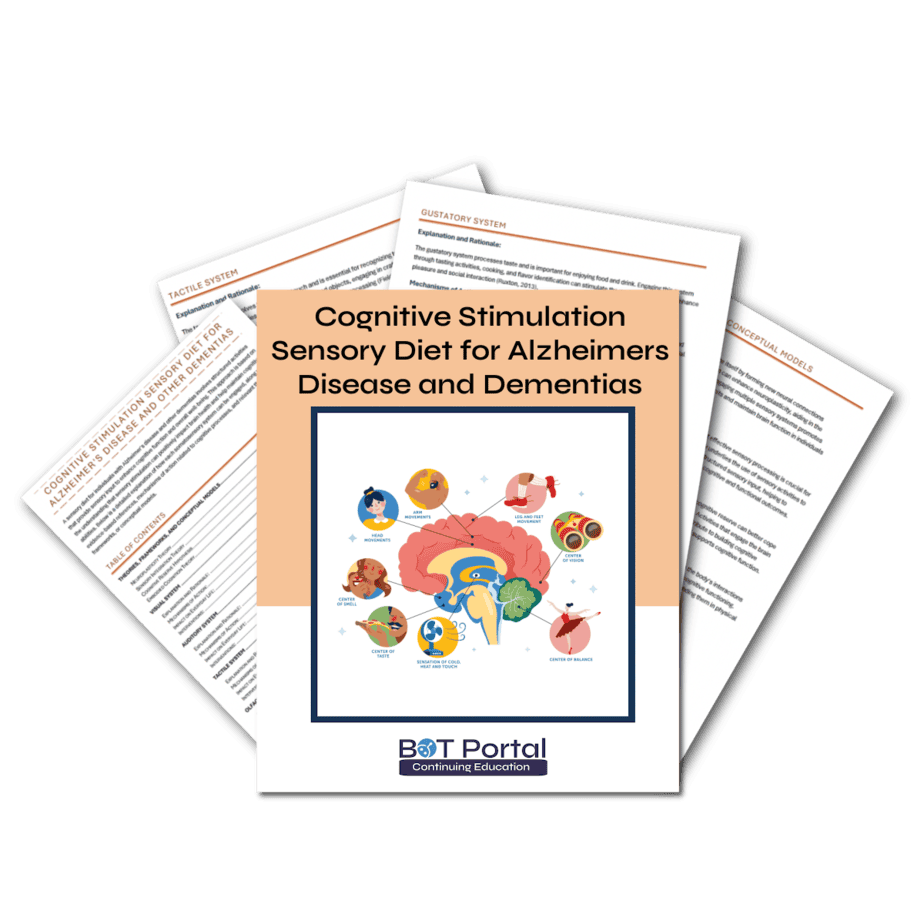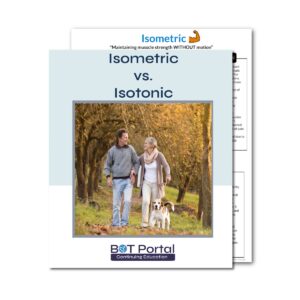Description
Sensory Diet for Dementia Cognitive Stimulation Activities
Sensory Diet for Occupational Therapy – Alzheimer’s and Dementias
Download the pdfs for Sensory Diet for Dementia for a printable packet to use with your patient with dementia or mild cognitive impairment This handout will help the therapist explore and create a sensory profile and diet for their patients to ensure all senses are being addressed throughout their day to day life.
More Information
A sensory diet is a therapeutic intervention that involves structured and purposeful sensory activities designed to meet the specific needs of individuals with Alzheimer’s disease and other dementias. This approach is grounded in the principles of sensory integration and cognitive neuroscience, aiming to enhance cognitive function, emotional well-being, and overall quality of life. Occupational therapists use sensory diets to provide holistic care that addresses the multifaceted impacts of dementia on sensory processing, cognition, and daily living.
Enhancing Neuroplasticity
One of the primary goals of a sensory diet is to promote neuroplasticity—the brain’s ability to reorganize and form new neural connections. Neuroplasticity is crucial for maintaining cognitive functions and compensating for the neural degradation seen in dementia. Sensory activities stimulate different regions of the brain, enhancing neural pathways and improving cognitive processes such as memory, attention, and problem-solving (Kolb & Gibb, 2014). For example, visual activities like puzzles and photo sorting engage the occipital and temporal lobes, which are involved in visual processing and memory recall.
Addressing Sensory Processing Deficits
Dementia often leads to changes in sensory processing, making it difficult for individuals to interpret and respond to sensory information accurately. A sensory diet helps normalize sensory experiences by providing consistent and structured sensory input. Activities that engage the tactile system, such as handling textured objects or engaging in crafts, stimulate the somatosensory cortex, improving sensory processing and fine motor skills (Field, 2010). Similarly, auditory activities like music therapy and sound identification games activate the auditory cortex, enhancing auditory processing and communication abilities (Särkämö et al., 2014).
Improving Emotional and Psychological Well-being
Sensory stimulation has a profound impact on emotional and psychological well-being. Activities that involve familiar scents, such as aromatherapy with lavender or rosemary, can trigger positive memories and emotions, enhancing mood and reducing anxiety (Jimbo et al., 2009). Engaging in sensory-rich activities also provides a sense of purpose and accomplishment, which is vital for maintaining self-esteem and motivation in individuals with dementia.
Promoting Physical Health and Mobility
Incorporating activities that engage the vestibular and proprioceptive systems helps maintain physical health and mobility. Balance exercises and gentle rocking stimulate the vestibular system, improving balance and spatial orientation, which are critical for preventing falls and enhancing independence (Horak, 2006). Proprioceptive activities like stretching and resistance exercises enhance body awareness and coordination, supporting overall motor function (Shumway-Cook & Woollacott, 2007).
Supporting Cognitive Reserve
The Cognitive Reserve Hypothesis suggests that engaging in cognitively stimulating activities can build and sustain cognitive reserve, helping individuals better cope with brain pathology (Stern, 2009). A sensory diet that includes diverse and meaningful activities supports this hypothesis by providing regular cognitive stimulation, thereby mitigating the impact of neurodegenerative changes and prolonging cognitive function.
Creating a Personalized and Enjoyable Routine
A sensory diet is highly customizable, allowing occupational therapists to tailor activities to the individual’s preferences, needs, and cognitive levels. This personalization ensures that the interventions are not only effective but also enjoyable, enhancing adherence and maximizing therapeutic benefits. Activities such as cooking, gardening, and music can be adjusted in complexity to match the individual’s abilities, ensuring they remain engaged and challenged appropriately.
What is included?
- 11 page sensory diet idea for stimulating cognitive processes using the sensory system in those with dementia and mild cognitive impairment
Sensory Diet OT




